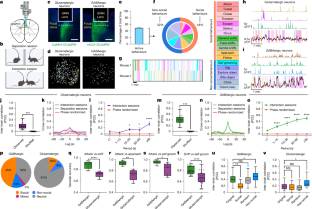
加州大学洪暐哲研究组在研究中取得进展。他们报道了生物和人工智能系统中的脑间神经动力学。该项研究成果发表在2025年7月2日出版的《自然》上。
为了了解这些相互作用的神经基础,课题组研究人员研究了小鼠和人工智能系统中个体的脑间神经动力学。通过测量社交互动小鼠背内侧前额叶皮层中分子定义神经元的活动,课题组发现每个个体内的多维神经空间可以划分为两个不同的子空间——一个代表动物之间共享的神经动力学的共享神经子空间和一个代表每个动物独特活动的独特神经子空间。值得注意的是,与谷氨酸能神经元相比,前额叶皮层背内侧的GABAergic (γ-氨基丁酸产生)神经元包含一个相当大的共享神经亚空间,这是由自我和他人的行为产生的。该课题组将这个框架扩展到人工智能代理,并观察到,随着社会互动的出现,交互代理之间共享的神经动力学也随之出现。重要的是,选择性地破坏有助于共享神经动力学的神经成分大大减少了代理人的社会行为。他们的研究结果表明,共享神经动力学代表了生物和人工媒介中相互作用的神经系统的基本和可概括的特征,并强调了共享神经动力学在驱动社会互动中的功能意义。
研究人员表示,社会互动可以被视为互动个体之间的动态反馈循环,因为他们相互行动和反应。
附:英文原文
Title: Inter-brain neural dynamics in biological and artificial intelligence systems
Author: Zhang, Xingjian, Phi, Nguyen, Li, Qin, Gorzek, Ryan, Zwingenberger, Niklas, Huang, Shan, Zhou, John L., Kingsbury, Lyle, Raam, Tara, Wu, Ye Emily, Wei, Don, Kao, Jonathan C., Hong, Weizhe
Issue&Volume: 2025-07-02
Abstract: Social interaction can be regarded as a dynamic feedback loop between interacting individuals as they act and react to each other1,2. Here, to understand the neural basis of these interactions, we investigated inter-brain neural dynamics across individuals in both mice and artificial intelligence systems. By measuring activities of molecularly defined neurons in the dorsomedial prefrontal cortex of socially interacting mice, we find that the multi-dimensional neural space within each individual can be partitioned into two distinct subspaces—a shared neural subspace that represents shared neural dynamics across animals and a unique neural subspace that represents activity unique to each animal. Notably, compared with glutamatergic neurons, GABAergic (γ-aminobutyric acid-producing) neurons in the dorsomedial prefrontal cortex contain a considerably larger shared neural subspace, which arises from behaviours of both self and others. We extended this framework to artificial intelligence agents and observed that, as social interactions emerged, so too did shared neural dynamics between interacting agents. Importantly, selectively disrupting the neural components that contribute to shared neural dynamics substantially reduces the agents’ social actions. Our findings suggest that shared neural dynamics represent a fundamental and generalizable feature of interacting neural systems present in both biological and artificial agents and highlight the functional significance of shared neural dynamics in driving social interactions.
DOI: 10.1038/s41586-025-09196-4
Source: https://www.nature.com/articles/s41586-025-09196-4
Nature:《自然》,创刊于1869年。隶属于施普林格·自然出版集团,最新IF:69.504
官方网址:http://www.nature.com/
投稿链接:http://www.nature.com/authors/submit_manuscript.html
